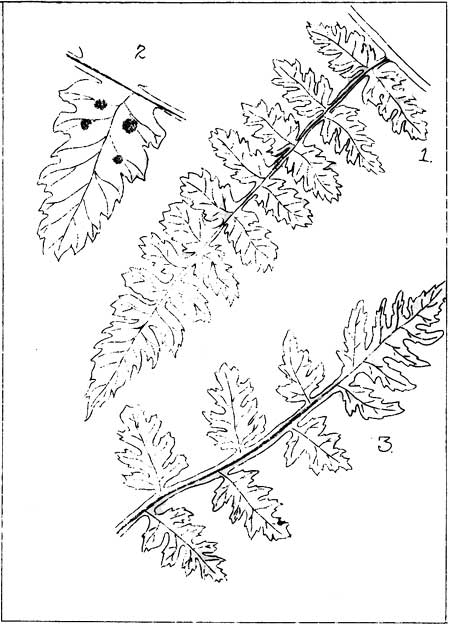 |
|
Lady Fern or Swap
Fern (Athyrium filix-femina); 1. Pinna (x2). 2. Pinnule (x9).
3. Pinna of Alpine Lady Fern (Athyrium alpestre, var.
americanum) (x3).
|
LADY FERN or SWAMP FERN
(Athyrium filix-femina (L.) Roth.)
This plant is one of the park's most common ferns. Its local
range is included within the Canadian zone from the lower park
boundaries to about 4000 feet. Its habitat is moist, wet humid
soils that may often be swampy in character. Its general range
indicated its wide distribution throughout North America for it is found
from Alaska to Newfoundland and south to California and Florida. In
general appearance it is a large and handsome plant, its long fronds
arching gracefully to form a broad open tuft of foliage. Individual
fronds are 2-3 pinnate, from 2-6 feet long, widest just below the
middle and tapering toward both ends; fronds are usually from 4-10
inches wide at the widest part. There is no difference in appearance
between spore bearing and non spore bearing fronds. The larger
pinnae are short stalked, linear to lanceolate in outline and the
pinnules are sessile with either crenate (wavy) or slightly
toothed margins; verination of pinnules free. The stalk of the
frond is short being only about one-fifth as long as the entire blade
and is green. Spores borne in oblong or horseshoe-shaped sori
becoming roundish with maturity; indusium present. This fern
bears abundant spores and reproduces itself readily, often being the
dominant vegetation in moist places. It is herbaceous rhizome creeping
to oblique.
At one time the rhizome of this plant was of some medicinal
importance (see Frye - "Ferns of the Northwest"; pp. 140.) According to
the old herbalists it was a vermifuge; if powdered and applied to ulcers
it was supposed to bring about a cure in that case, as well as a means
of healing the galled necks of cattle. The ancients considered it
effective as a remedy for gallstones, hiccough, and infirmaries of the
spleen as well as an aid in the cure of jaundice - provided it was
boiled in wine and this concoction imbibed for forty days.
-oOo-
ALPINE LADY FERN.
(Athyrium alpestre,
var. americanum Butters)
As the name implies this fern is native to the upper elevations in
the mountains. In Mount Rainier National Park it is most generally
found in the Hudsonian zone, growing in compact clusters in talus. One
of its most striking characters of a general nature is the erect,
"stiffish" appearance of the densely clustered pinnae. Botanically
its range includes the area from Alaska southward to California and
eastward to Colorado. The fronds are 2-3 compound; 7-36 inches
long and 2-3 inches wide, widest just below the middle and tapering
toward each end. The stalk is short, straw colored and having straw
colored scales at the base. The stalks of several fronds, which make up
a cluster, are often entwined and curved beneath the rocks from which
they grow. Larger Pinnae are stalked, widest at the base and
somewhat triangular in outline. Those toward the base of the stalk are
spaced further apart than those at the center. Pinnules incised
to pinnate; sessile to short stalked. Sori round.
-oOo-

